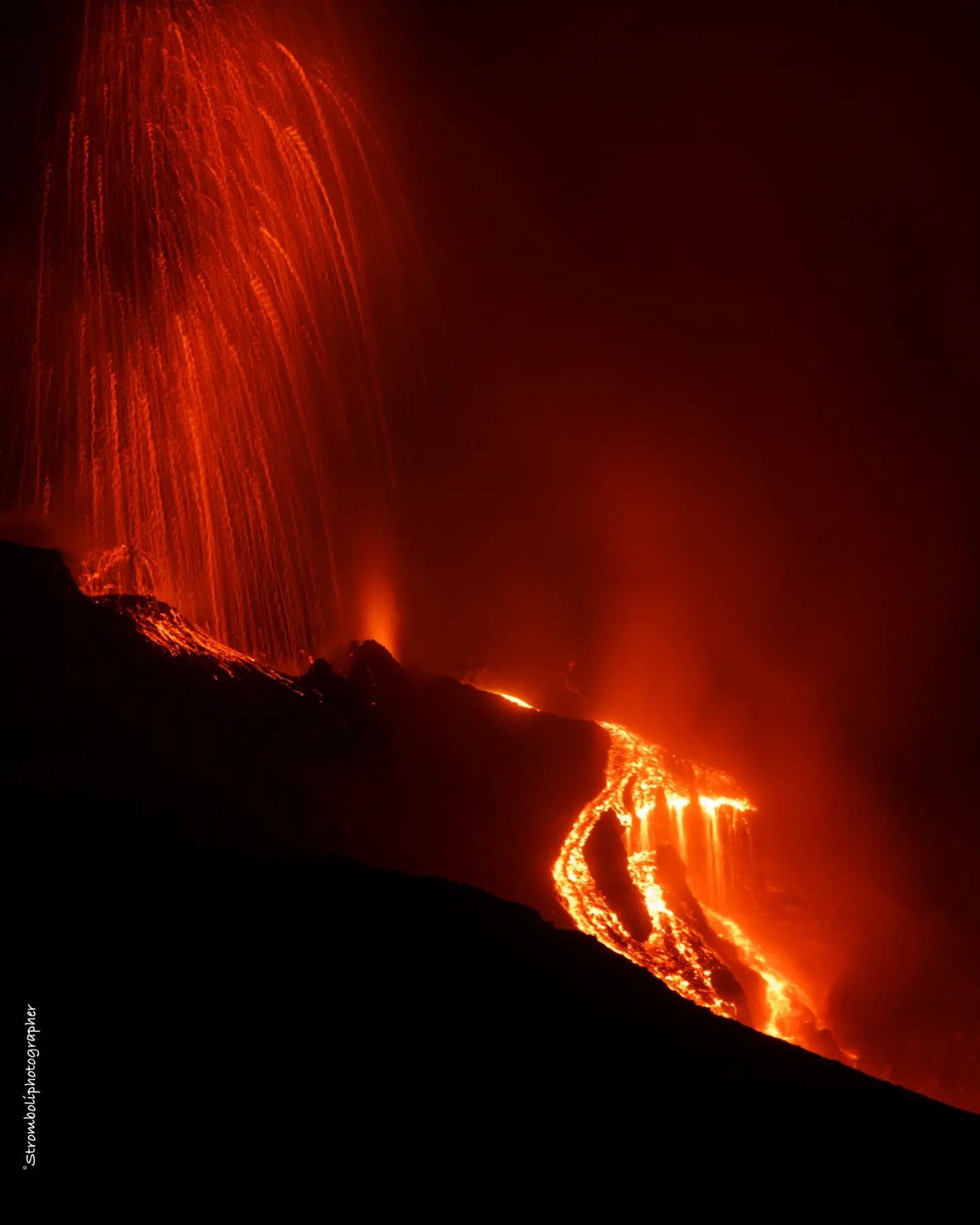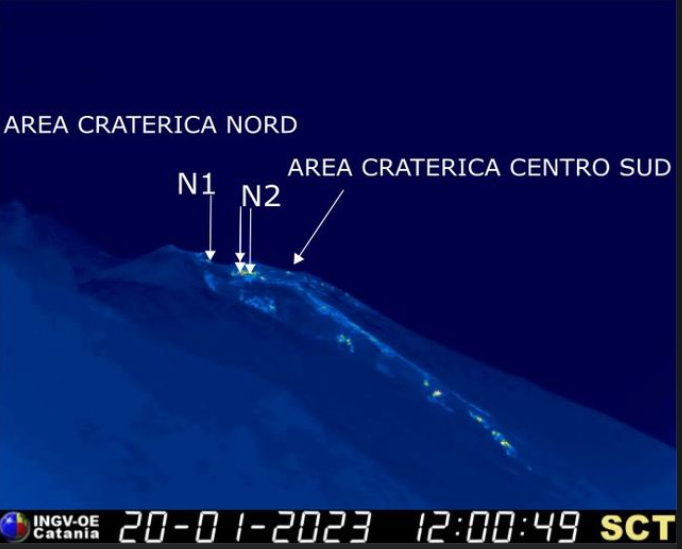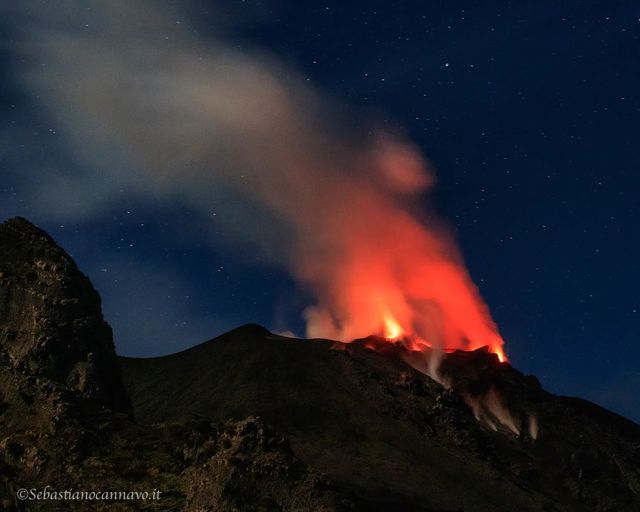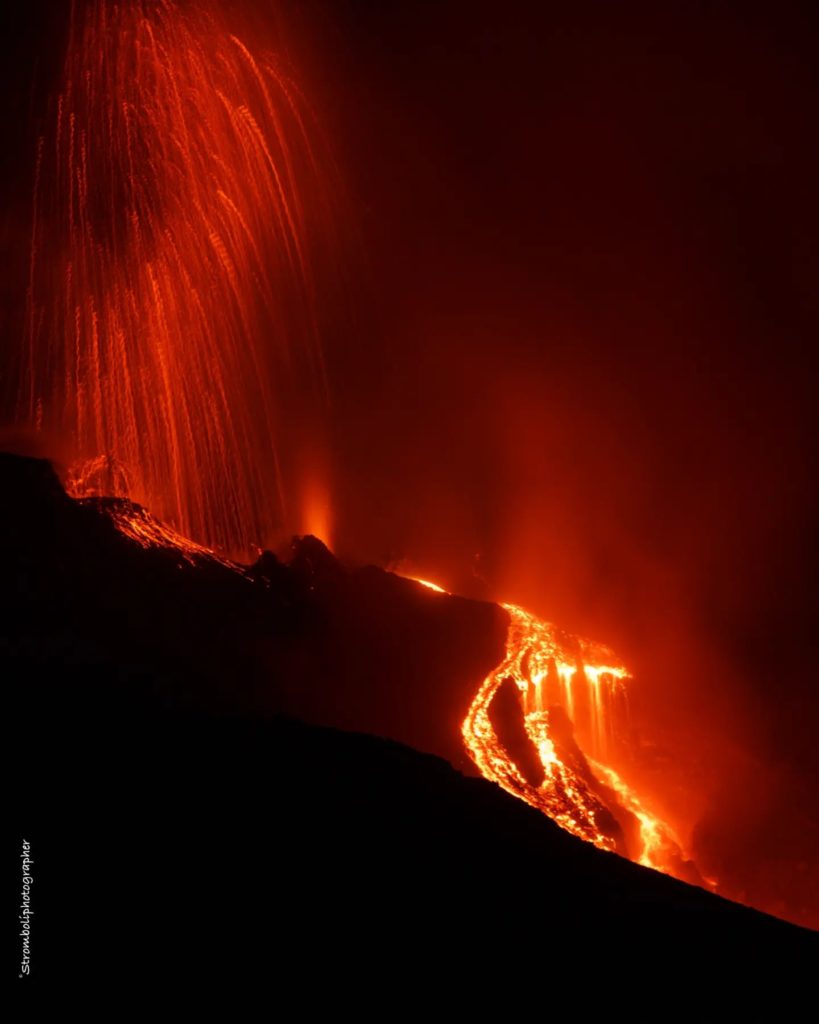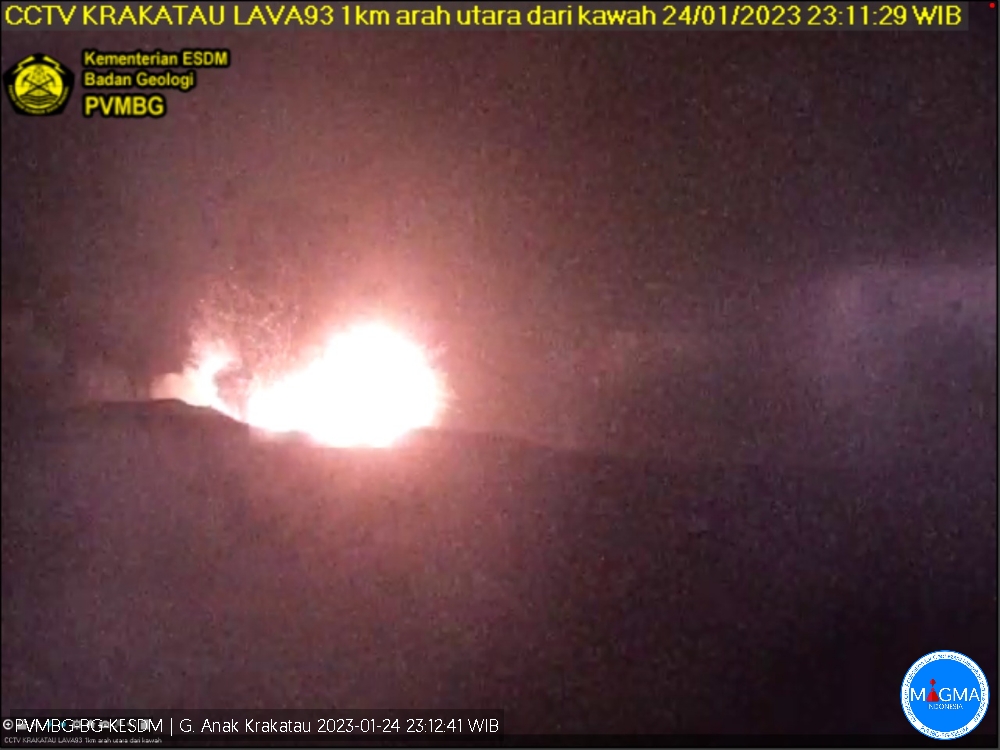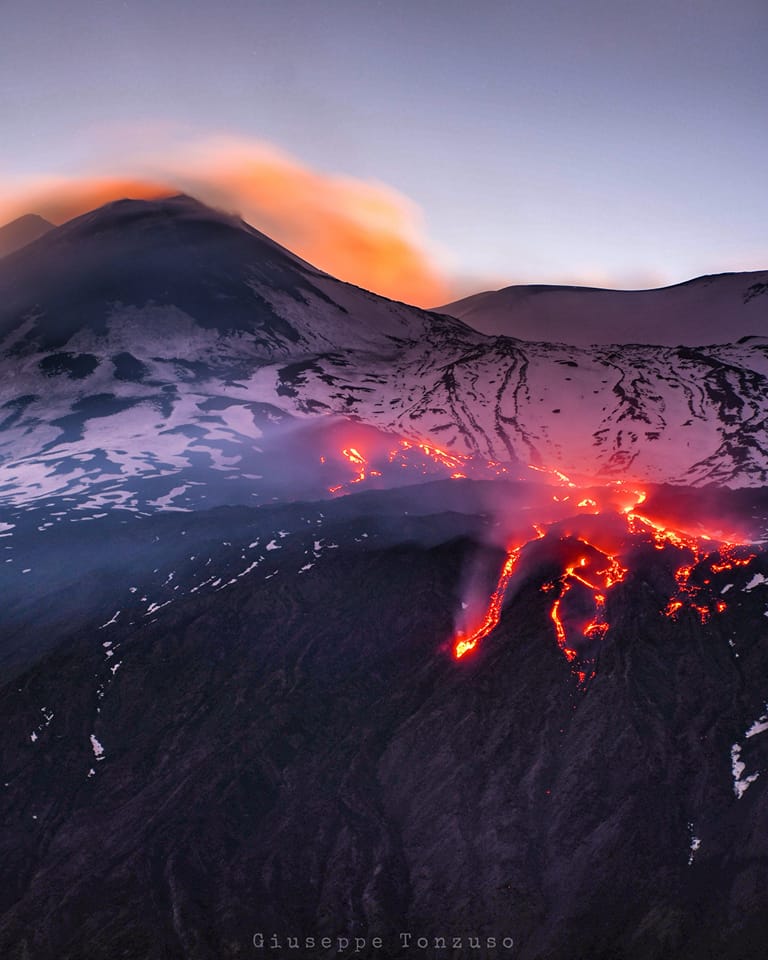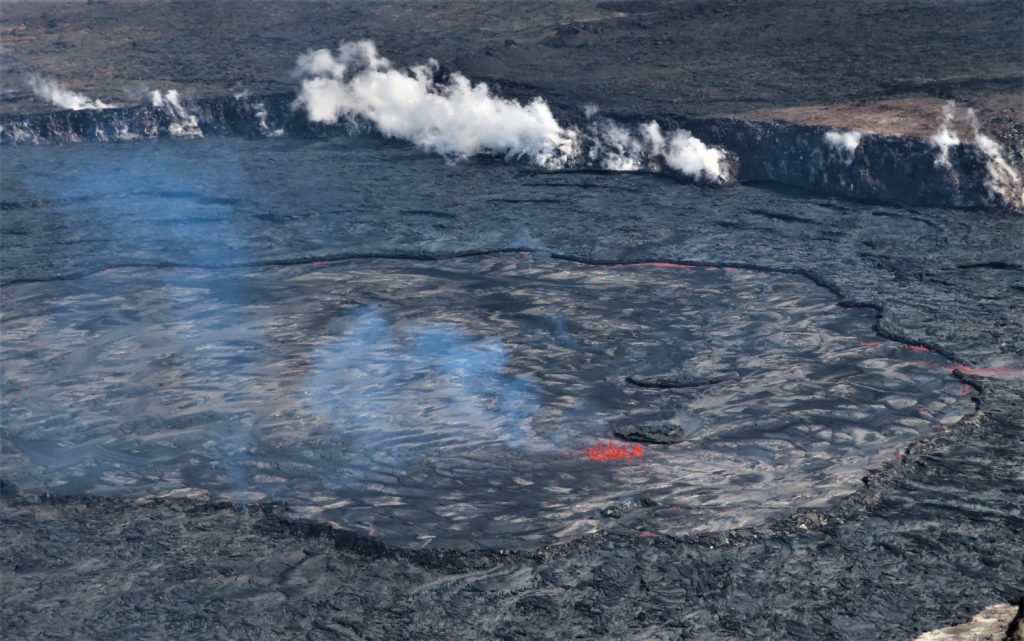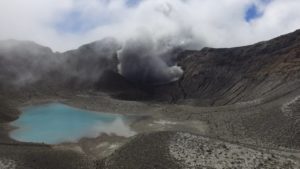January 25 , 2023.
Italy , Stromboli :
WEEKLY BULLETIN, from January 16, 2023 to January 22, 2023. (issue date 24 January 2023)
ACTIVITY STATUS SUMMARY
In the light of the monitoring data, it is highlighted:
1) VOLCANOLOGICAL OBSERVATIONS: During this period, normal Strombolian activity was observed with spattering activity and lava overflow in the North Crater area. The total hourly frequency oscillated between low (3 events/h) and medium-low (9 events/h) values. The intensity of the explosions was mainly medium and low in the North crater area and medium to high in the South Center crater area.
2) SEISMOLOGY: The seismological parameters do not show significant variations.
3) SOIL DEFORMATIONS: The island’s soil deformation monitoring networks have not shown any significant variations over the past week.
4) GEOCHEMISTRY: The flow of SO2 at an average level
CO2 flux in the crater area: stable on medium-high values.
CO2/SO2 ratio on average values.
Isotope ratio of helium in groundwater: there are no updates, the last figure dated 20-12-22 on medium-high values.
5) SATELLITE OBSERVATIONS: The thermal activity observed from the satellite was generally weak. High heat flux values were observed on January 17, 2023 in correspondence with the lava overflow in the summit area.
VOLCANOLOGICAL OBSERVATIONS
The explosive activity was mainly produced by 4 (four) eruptive vents located in the northern zone of the crater and by one located in the central southern zone. The mouths of the North crater area are located in the upper part of the Sciara del Fuoco while the mouth of the central South crater area is located inside the crater terrace. In detail, in the northern area of the crater, a vent is located near sector N1 while the other three are located near sector N2. Due to a technical failure, as of 19:58 UTC on January 20, 2023, camera images were no longer available for analysis of eruptive activity.
On January 17, 2023, a lava overflow affected the vents located in the northern area of the crater.
Observations of explosive activity captured by surveillance cameras:
In the northern area of the crater (N), explosive activity was observed only from the vents located inside the Sciara del Fuoco in its upper part after the collapse of the northern rim. The four vents showed explosive activity (explosions of varying intensity from low (less than 80 m in height) to medium (less than 150 m in height) emitting coarse materials (bombs and lapilli)). In addition, spattering activity was observed throughout the observation period from vents located in the N2 sector. The average frequency of explosions fluctuates between 3 and 6 events/h.
In the Center-South (CS) zone, explosive activity of medium and high intensity was observed (sometimes the products exceeded 250 in height) emitting fine materials (ash) mixed with coarse materials. The frequency was variable between 2 and 5 events/h.
Lava overflow of January 17, 2023.
At 09:52 UTC, after intense spattering activity from the vents of the N2 sector of the North zone, an overflow of lava began, which began to flow abundantly in the upper part of the Sciara del fuoco, splitting into two flows main lines, one in the direction of the ravine created on October 9, 2022 and the other longitudinally to the point of emission. In the afternoon, the lava flows appeared decreasing and at 6:00 p.m. cooling.
Statement on Stromboli activity, January 24, 2023, 16:57 (15:57 UTC).
The National Institute of Geophysics and Volcanology, Osservatorio Etneo, communicates that from the analysis of the surveillance cameras, it is observed that an overflow of lava is in progress from the area of the North crater, which began towards 2:20 p.m. UTC. At 2:22 p.m. there was also a slide of unstable material, which reached the sea at the base of the Sciara del Fuoco. The lava overflow is still ongoing. From the seismic point of view, the average amplitude of the volcanic tremor remains within the range of average values. At 2:19 p.m. UTC there was a seismic signal linked to block rolling phenomena for about 6 minutes. There are no significant variations in the occurrence rate and amplitude of explosive earthquakes. Data from soil deformation monitoring networks show no significant variations.
Further updates will be communicated soon.
Source : INGV.
Photos : INGV , Sebastiano Cannavo / Stromboli Stati d’animo , Stromboli Stati d’animo.
Indonesia , Anak Krakatau :
An eruption of Mount Anak Krakatau occurred on Tuesday, January 24, 2023 at 11:11 p.m. No visual rash was observed. This eruption was recorded on a seismograph with a maximum amplitude of 60 mm and a duration of 70 seconds.
VOLCANO OBSERVATORY NOTICE FOR AVIATION – VONA
Issued : January 24 , 2023
Volcano : Anak Krakatau (262000)
Current Aviation Colour Code : ORANGE
Previous Aviation Colour Code : orange
Source : Anak Krakatau Volcano Observatory
Notice Number : 2023KRA025
Volcano Location : S 06 deg 06 min 07 sec E 105 deg 25 min 23 sec
Area : Lampung, Indonesia
Summit Elevation : 502 FT (157 M)
Volcanic Activity Summary :
Eruption at 16h11 UTC (23h11 local).
Volcanic Cloud Height :
Ash-cloud is not observed.
Other Volcanic Cloud Information :
Ash-cloud is not observed.
Remarks :
Eruption recorded on seismogram with maximum amplitude 60 mm and maximum duration 70 second.
Source et photo : Magma Indonésie.
Italy / Sicily , Etna :
WEEKLY BULLETIN, from January 16, 2023 to January 22, 2023. (issue date 24 January 2023)
ACTIVITY STATUS SUMMARY
In the light of the monitoring data, it is highlighted:
1) VOLCANOLOGICAL OBSERVATIONS: Effusive activity with lava flows in the Vallée del Leone, degassing at variable speed from the summit craters.
2) SEISMOLOGY: Low seismic activity due to fracturing; the amplitude of the volcanic tremor remained mainly at medium-low levels.
3) INFRASOUND: Weak infrasonic activity.
4) GROUND DEFORMATIONS: During the last week, the ground deformation monitoring networks have not recorded any significant variations.
5) GEOCHEMISTRY: SO2 flux at a moderately medium-low level
The soil CO2 flux values recorded last week are average values.
The CO2 in groundwater (EtnaAcque Network) does not show variations apart from the seasonal variability of the site.
Shaded model of the relief of the summit craters of Etna obtained by processing drone images acquired during several overflights (September 15 and 21, 2022, October 6, 21 and 23), superimposed on the shaded model from the Pléiades images of August 22, 2020 ( AO Telerivamento). CSE = Southeast Crater, CNE = Northeast Crater, BN = Bocca Nuova, VOR = Voragine. The red polygon delimits the area of current effusive activity.
6) SATELLITE OBSERVATIONS: The thermal activity observed by satellite in the summit zone was of a high level in correspondence with the effusive eruption in the summit zone.
7) OTHER OBSERVATIONS: The magma which fed the current eruption during the first twenty days of activity has the most evolved composition among those of the Southeast Crater in 2022.
There is therefore no evidence of significant upwelling of new, deep, primitive magma into the magmatic « reservoir » (reservoir) that feeds the ongoing activity.
VOLCANOLOGICAL OBSERVATIONS:
During the week under review, the effusive activity which began on November 27, 2022 from the mouth which opened at the North-East base of the South-East crater at an altitude of approximately 2800 m is continued, although with strong fluctuations. During the night of January 16 to 17, the lava emission gradually decreased and had practically ceased by the late afternoon of the 17th. In the early hours of January 18, effusive activity resumed, generating two lava flows , one directed to the northeast, along the western margin of the lava field, and the other to the east, on the steep western wall of the Valle del Bove. The most advanced fronts remained confined to an altitude between approximately 2500 and 2400 m and, in particular, at an altitude of 2450 m on 19 January. The latter reached the base of the wall on January 20.
The next day, the effusive rate decreased again to increase again in the evening; on the evening of January 22, a new flow descended towards the Valle del Bove and approached the base of its western wall, around 2200-2250 m altitude.
The area covered from November 27, 2022 to January 19, 2023 is equal to 7.5 x 10^5 m2 and the total volume is between 3.7 and 4.8 x10^6 m^3. This estimate is preliminary and an error of approximately 40% is estimated.
The activity of the summit craters was characterized by degassing at a variable level, mainly to the detriment of the Bocca Nuova crater where the degassing continued identically to the previous weeks; however, no nightglow was observed at this crater. At the Southeast crater, the fumarolic degassing was mainly located along the rim of the crater and in correspondence with the eruptive vent of May-June 2022. The degassing of the Northeast crater and the Voragine crater, on the contrary, remained extremely mild, being visible only in conditions of atmospheric humidity.
Source : INGV.
Photos : INGV , Giuseppe Tonzuso
Chile , Tupungatito :
Special report on volcanic activity (REAV), Santiago Metropolitana region, Tupungatito volcano, January 25, 2023, 04:45 a.m. local time (mainland Chile).
The National Service of Geology and Mines of Chile (Sernageomin) publishes the following PRELIMINARY information, obtained through the monitoring equipment of the National Volcanic Monitoring Network (RNVV), processed and analyzed at the Volcanological Observatory of the Southern Andes ( Ovdas):
On Wednesday January 25, 2023, at 03:45 local time (06:45 UTC), the monitoring stations installed near the Tupungatito volcano recorded an earthquake associated with the fracturing of rocks (volcano-tectonic type) in the volcanic system.
The characteristics of earthquakes after their analysis are as follows:
ORIGINAL TIME: 03:45 local time (06:45 UTC)
LATITUDE: 33.393°S
LONGITUDE: 69.785°E
DEPTH: 15.4 km
LOCAL MAGNITUDE: 3.5 (ML)
COMMENTS:
Before the occurrence of the volcano-tectonic event, events of lower energy were recorded.
The volcanic technical alert remains at the Green level.
Source et photo : Sernageomin.
Hawaii , Kilauea :
Tuesday, January 24, 2023, 8:59 AM HST (Tuesday, January 24, 2023, 18:59 UTC)
19°25’16 » N 155°17’13 » W,
Summit Elevation 4091 ft (1247 m)
Current Volcano Alert Level: WATCH
Current Aviation Color Code: ORANGE
Activity Summary:
The summit eruption of Kīlauea Volcano, within Halemaʻumaʻu crater, continued over the past 24 hours. All recent eruptive activity has been confined to the crater. No significant changes have been observed at the summit or in either rift zone.
Halemaʻumaʻu crater Lava Lake Observations:
Eruption of lava in the eastern portion of Halemaʻumaʻu crater floor continued over the past 24 hours. Activity is concentrated in a large lava lake in the eastern half of the crater, as well as a smaller lake to the west, in the basin of the 2021–2022 lava lake. The eastern lava lake has one dominant fountain and an area of approximately 25 acres as of January 17. The lake is currently well-defined by its levee boundaries, though there are periods of frequent overflows.
View of the active lava lake in the eastern side of Halema‘uma‘u crater, at the summit of Kīlauea. A perched levee consisting of stacked crustal plates a few meters (yards) tall surrounds the lake. A fountain (orange) is present on the southwest side of the lake. At the time the photo was taken, a flow had breached the levee on the south (right) side. .
Summit Observations:
Summit tiltmeters began recording deflationary tilt yesterday afternoon, consistent with the start of a summit Deflation-Inflation (DI) event. Volcanic tremor remains above background levels. A sulfur dioxide (SO2) emission rate of approximately 3,000 tonnes per day (t/d) was measured on January 20, 2023.
Source : HVO
Photo : USGS / J.M. Chang.

